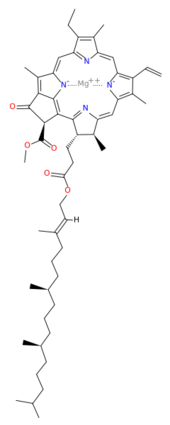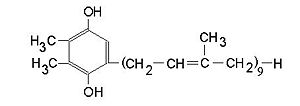Photosystem II: Difference between revisions
| Line 9: | Line 9: | ||
==Electron Transfer== | ==Electron Transfer== | ||
[[Image:Chlorophyll_a.svg.png|thumb|170px|left|structure of chlorophyll ''a'']] | [[Image:Chlorophyll_a.svg.png|thumb|170px|left|structure of chlorophyll ''a'']] | ||
<scene name='Photosystem_II/Chlorophyll_green/ | <scene name='Photosystem_II/Chlorophyll_green/2'>Chlorophyll</scene> surround Photosystem II and capture energy from sunlight, exciting electrons. Chlorophyll are highly conjugated and absorb visible light, along with accessory light harvesting pigments such as <scene name='Photosystem_II/Betacarotene/2'>beta carotene</scene>. Beta carotene absorbs visible light of other wavelengths and also protects Photosystem II by destroying reactive oxygen species that result from this photoexcitation. [[Image:b-car.svg.png|b-car.svg.png|thumb|right|400px|structure of beta carotene]] Electrons are passed from chlorophyll to <scene name='Photosystem_II/Pheophytin_purple/4'>pheophytin</scene>. Pheophytin are very similar to chlorophyll except they contain 2 H<sup>+</sup> instead of a Mg<sup>2+</sup> ion. From the pheophytin, electrons transferred to <scene name='Photosystem_II/Quinone_pink/4'>plastoquinones</scene>, which are reduced. Between each pair of quinones, an iron, in red, helps to transfer the electron. These plastoquinones eventually move to a plastoquinone pool which travels to another large protein subunit, cytochrome b <sub>6</sub>/ f. Eventually these electrons reduce NADP<sup>+</sup> to NADPH. Here the <scene name='Photosystem_II/Electron_pathway/2'>electron pathway</scene> through Photosystem II is shown, with '''<FONT COLOR="#F87217">beta-carotenes</FONT>''', '''<FONT COLOR="#571B7e">pheophytins</FONT>''', '''<FONT COLOR="#E42217">iron</FONT>''' and '''<FONT COLOR="#F535AA">plasotoquinones</FONT>'''. | ||
[[Image:plastoquinone.jpg|thumb|300px|right|reduced plastoquinone]] | [[Image:plastoquinone.jpg|thumb|300px|right|reduced plastoquinone]] | ||
Revision as of 04:37, 6 May 2008
|
BackgroundBackground
This structure of Photosystem II was crystallized from the bacteria, Thermosynechococcus elongatus, at 3.50 Å. Cyanobacteria and plants both contain Photosystem II with a similar structure. This photosynthetic protein is associated with a variety of functional ligands. It is a composed mainly of alpha-helices. Nineteen are in each monomer, with multiple extrinsic subunits associated with the oxygen evolving complex missing from this crystallization. Photosystem II is a membrane bound protein associated with the thylakoid membrane of chloroplasts. regions correlate with membrane associated nature of the protein. Hydrophobic helices make up the transmembranal portion, while polar residues are concentrated externally on either side of the membrane.
PhotosynthesisPhotosynthesis
Photosystem II is an integral part of photosynthesis, the conversion of light energy into chemical energy by living organisms. Photosystem II is linked to a variety of other proteins, including Photosytem I. These proteins ultimately produce NADPH and ATP that power the Calvin cycle. Using this energy, glucose is synthesized from carbon dioxide and water.
Electron TransferElectron Transfer

surround Photosystem II and capture energy from sunlight, exciting electrons. Chlorophyll are highly conjugated and absorb visible light, along with accessory light harvesting pigments such as . Beta carotene absorbs visible light of other wavelengths and also protects Photosystem II by destroying reactive oxygen species that result from this photoexcitation.

Electrons are passed from chlorophyll to . Pheophytin are very similar to chlorophyll except they contain 2 H+ instead of a Mg2+ ion. From the pheophytin, electrons transferred to , which are reduced. Between each pair of quinones, an iron, in red, helps to transfer the electron. These plastoquinones eventually move to a plastoquinone pool which travels to another large protein subunit, cytochrome b 6/ f. Eventually these electrons reduce NADP+ to NADPH. Here the through Photosystem II is shown, with beta-carotenes, pheophytins, iron and plasotoquinones.

Oxygen EvolutionOxygen Evolution
Another important facet of photosystem II is its ability to oxidize water to oxygen with its . These were shown to be cubane-like Mn3CaO4cluster linked to a fourth Mn by a mono-μ-oxo bridge. [1] Purple represents manganese, red represents oxygen and green is for calcium. Oxidation of water to leaves 2 H + on the lumenal side of the membrane, helping to establish the proton gradient essential for ATP synthesis in the CF1CF0-ATP sythase protein.
ReferencesReferences
[1] Ferreira, K.N., Iverson, T.M., Maghlaoui, K., Barber, J., Iwata, S. "Architecture of the photosynthetic oxygen-evolving center." Science, March 19, 2004, 303 (5665), 1831-8.
[2] Garrett, R.H., Grisham, C.M. Biochemistry, 3rd Edition. Belmont, CA: Thomson Brooks/ Cole, 2005.